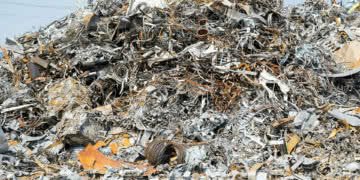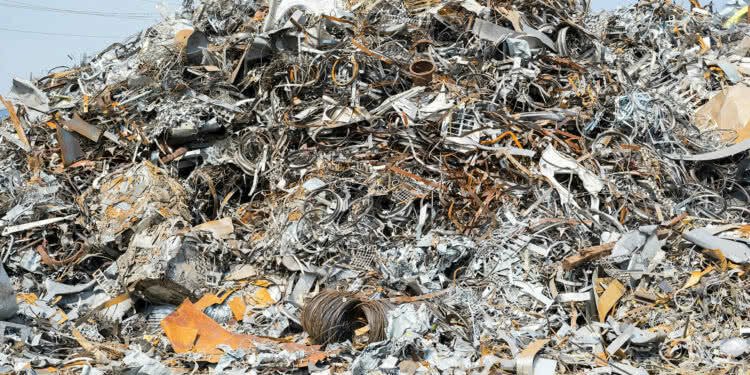From January 1, 2020, the export of ferrous and non-ferrous metal scrap from Russia to countries outside the EAEU is expected to be through organised trading exchange.
According to the draft resolution on amendments to the Russian Federation Acts of the Government for handling scrap of ferrous and non-ferrous metals, the export of ferrous and non-ferrous metal scrap and waste can proceed to states who are not members of the EAEU if supply contracts have been concluded at the trade exchange.
As stated in a document published on the regulation.gov.ru, this will create the most transparent conditions for scrap and waste export, as well as “ensure non-discriminatory access for domestic consumers to scrap trading”. In early summer, the Deputy Head of the Ministry of Industry and Trade, Viktor Yevtukhov, announced that the Ministry was discussing the organisation of centralised trading for ferrous and non-ferrous scrap metals through the St. Petersburg Commodity and Raw Materials Exchange amid a shortage of scrap supply in the country.
As stated in the explanatory note to the draft resolution, the volume of scrap collection in the Russian Federation has been at a level of 25-27 million tons per year over the past 10 years. At the same time, the total electric steelmaking capacities in the Russian Federation for the period from 2010 to 2016 increased from 27.5 million tons to 36.7 million tons. The average purchase price of metal scrap during the following 2 years (2017 and 2018) increased by 52.5%. “Export of more than 4 million tons of scrap per year (excluding Belarus) causes a scrap deficit in the domestic market and leads to a speculative peak price increases,” the document says.
However, the “National self regulating organisation of ferrous and non-ferrous scrap and waste processors and vehicle recyclers” (Association “RUSLOM.COM”) estimated the ferrous scrap collection in the country at 35 million tons per year and its consumption by domestic steelmaking at approximately 28.5 million tons per year (capacity utilisation of steelmaking companies usually does not exceed 80%). At the same time, according to the Association, ferrous scrap generation in the country is exceeding 45 million tons per year and measures to stimulate efficient collection of scrap as well as increasing the recycling rate to at least 90% are necessary. The Association considers the export of scrap as one such measure: excess of generated scrap should not remain in the country on the ground and to be destroyed by corrosion.
While the waste processing technologies in the world are rapidly updated and the depth of processing and the degree of metal recovery is being improved in most developed countries. The volume of scrap generated in Russia during the next decade will increase and therefore, the Russian scrap industry needs to invest today in new equipment and build “metal recycling plants” which will be similar to iron ore enterprises having stages of sorting, crushing, beneficiation and even preliminary melting (in the case of non-ferrous and rare metals recycling). Export of surplus metal scrap provides the main income for the Russian domestic scrap industry, which means that while this export is “alive”, the scrap industry is existing and developing and there will be scrap available for the domestic consumer as well. As soon as export stops, the scrap industry’s profitability will drop significantly, volumes of scrap collection will inevitably decrease and imported scrap will begin to be delivered to the country.
Examples abound. As is well known, on February 28, 2019, the Verkhovna Rada of Ukraine adopted a law for increasing the export duty on ferrous scrap from 42 to 58 euros per ton.
From January to July 2019, Ukrainian enterprises reduced the export of scrap of ferrous metals by 7.6 times compared to the same period during 2018 – down to 36.9 thousand tons. In monetary terms, scrap exports fell by 9.1 times down to $ 10.1 million. In July, 0.204 thousand tons of scrap metal were exported, in June – 0.208 thousand tons, in May – 8.086 thousand tons, in April – 8.791 thousand tons, in March – 8.246 thousand tons, in February – 8.252 thousand tons, in January – 3.140 thousand tons. During the same period, from January to June 2019, Ukraine increased its imports of metal scrap by 52.7% – up to 39.3 thousand tons due to a decrease in domestic scrap collection. Scrap was imported mainly from Turkey (49.50% of supplies by value) and from Russian Federation (41.65%).
This has led to a new draft resolution being registered in the Rada for the abolition of the earlier adopted increase in export duties. If it is passed, the export duty will be reduced to 8.5 euros per ton as early as in September, which will allow scrap collectors to freely export scrap abroad again.
Scrap enterprises belong to the raw materials sector. The above-mentioned Ukrainian example of restricting raw material export is not the only one in history. Some countries supplying raw materials globally impose duties on their exports or impose export barriers in various ways. The list of measures to curb export activity is quite wide: from export duties, bans and licensing to price or tax regulations. Basically, these restrictions are applied by poor or developing countries. The reason for introducing export duty on raw materials and scrap is often the inability of a particular country to receive income from other activities or the desire of the state to limit the illegal collection of scrap metal and its delivery abroad by criminal layers of society. In other cases, as proven by experience and economic theory, export restrictions on raw materials and scrap are introduced at risk to the economy of the country.
Experience has shown that export controls can initiate similar actions in other supplier countries, thereby raising prices even more and exacerbating their volatility, creating a crisis of confidence that spreads from one trade participant to another. Nobody wins. Countries that use restrictions on the export of scrap or minerals often rely heavily on imports of other minerals or materials, where they may face limited supply due to the use of similar trading instruments by other countries. These and other circumstances are a strong argument in favor of eliminating export restrictions.
This is why developed countries intentionally do not limit the export of raw materials, especially when the country is leading the world market with such materials. There are many facts and methods developed by economists proving that the imposed restriction on the export of raw materials by a particular country is fraught with consequences for its exporters of finished products and products of further processing, that is, for the economy of the country as a whole.
It is a mistake to believe that supporting domestic producers is worthy of such risky actions. Experience shows that the domestic producer will receive only a short-term positive effect. The introduction of export restrictions on raw materials positively affects the competitiveness of the country’s processing industries but most often only their primary production. In the case of the steelmaking industry, this is the production of steel billets and slabs. The economy of the producing of such semi-finished products will improve significantly: manufacturing enterprises will be more profitable, compete successfully in export markets due to lower prices and will increase their production and export. Russia supplies more than 40% of the semi-finished steel products in the world, the geography of its supplies covers all regions; hence, the Russian export pricing policy determines the global price dynamics for steel billets and slabs. Restricting exports will lead to lower world prices for semi-finished steel products internationally. After that, Russia’s global competitors for products of subsequent steel processing (for example, steel pipe manufacturers) will have cheaper raw materials, will produce cheaper pipes and Russian steel pipe manufacturers will lose when trading for export. There will be a kind of “shift” of profit from one segment of the industry to another (in our example: from Russian steel pipe exporters to Russian billets/slab exporters).
Further, the production of domestic raw materials (in our case, steel scrap in Russia) will begin to decline since the scrap industry will lose profits and will not be able to maintain a profitable economy. Russian scrap suppliers will lose a significant part of their export earnings, lose their export markets (very likely forever, since China will close this niche very quickly), will reduce investment in the scrap processing sector, will reduce scrap collection, processing and supply, and very soon imported scrap will appear in Russia.
In addition, the restriction of raw material export is considered as indirect subsidisation of the domestic producer, which runs counter to the WTO rules. It entails the risk of countermeasures by the WTO member countries, namely the introduction of anti-dumping measures and a significant increase in import tariffs on products from the violating country. Subsequent Russian value added steel products may lose access to the world markets due to trade disputes and import restrictions. Prices in the global steel market will be fluctuating once again.
However, once more we want to “invent a bicycle” by regulating export through exchange trading, thereby restricting it but in a new way: let’s look on some facts.
According to the Pipe Industry Development Fund (FRTP) which is lobbying for the interests of the largest Russian pipe producers, restricting the export of steel scrap will stabilise the capacity utilisation in the steelmaking and curb the production cost growth of the of metal pipe products.
At the end of June, the introduction of a temporary quota for the export of waste and scrap of ferrous metals effective from July 1, 2019 was widely discussed. The Ministry of Industry and Trade will be entrusted with introducing the respective draft resolution to the government.
In early June, a source from Interfax reported that the idea for introducing a temporary quota for exporting waste and scrap of ferrous metals, differentiated by region, was discussed at a meeting with Russian Deputy Prime Minister Dmitry Kozak. According to the interlocutor of the agency, the quota in Russia, on average, will be at the level of 60-70% of historical export volumes. At the same time, it will not apply to the EAEU countries, including Belarus, where roughly 1 million tons of scrap are delivered annually.
Recently it became known that the Ministry of Industry and Trade, the Ministry of Economic Development, the Ministry of Finance and the Federal Antimonopoly Service of the Russian Federation must introduce to the government by September 1, the draft amendments regarding the alienation of scrap and waste of ferrous and non-ferrous metals due to planned organisation of trade in scrap through exchanges, effective from January 1, 2020.
According to the Russian State Customs Committee, the export of ferrous scrap from January to May 2019 decreased by 19.7% to 1.85 million tons compared to the same period last year. 44.0% was exported to Turkey, 23.0% to the Republic of Belarus, 11.6% to South Korea and 21.4% to other countries. 450.7 thousand tons of such scrap was exported in May.
In March, the Association of Commercial Sea Ports (ASOP) stated that there was no shortage of scrap metal in Russia since the total volume of scrap collection exceeds the needs of Russian steelmaking industry. Significant volumes of scrap export happened through the ports in regions where there are no steelmaking enterprises. The ban or restrictions on the export of ferrous scrap, according to ASOP, could lead to “significant negative consequences” for specialised port operators. In 2018, more than 40 stevedores in all regions of the country exported almost 4 million tons of this type of cargo. Scrap metal at some ports makes up a significant share of cargo turnover (up to 30-40%).















